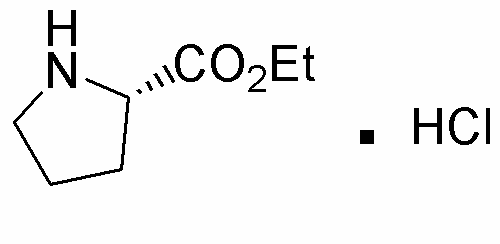L-Proline ethyl ester hydrochloride is widely utilized in research focused on:
- Peptide Synthesis: This compound serves as a valuable building block in the synthesis of peptides, particularly in the pharmaceutical industry, where it can enhance the stability and bioactivity of peptide drugs.
- Chiral Auxiliary: It acts as a chiral auxiliary in asymmetric synthesis, allowing chemists to produce enantiomerically pure compounds, which are crucial in drug development.
- Biochemical Research: Researchers use it to study protein folding and stability, providing insights into enzyme mechanisms and potential therapeutic targets.
- Food Industry: It can be applied in the formulation of flavor enhancers and food additives, improving the taste profile of various products.
- Cosmetic Formulations: The compound is also incorporated into cosmetic products for its moisturizing properties, contributing to skin hydration and overall product efficacy.
General Information
Properties
Safety and Regulations
Applications
L-Proline ethyl ester hydrochloride is widely utilized in research focused on:
- Peptide Synthesis: This compound serves as a valuable building block in the synthesis of peptides, particularly in the pharmaceutical industry, where it can enhance the stability and bioactivity of peptide drugs.
- Chiral Auxiliary: It acts as a chiral auxiliary in asymmetric synthesis, allowing chemists to produce enantiomerically pure compounds, which are crucial in drug development.
- Biochemical Research: Researchers use it to study protein folding and stability, providing insights into enzyme mechanisms and potential therapeutic targets.
- Food Industry: It can be applied in the formulation of flavor enhancers and food additives, improving the taste profile of various products.
- Cosmetic Formulations: The compound is also incorporated into cosmetic products for its moisturizing properties, contributing to skin hydration and overall product efficacy.
Documents
Safety Data Sheets (SDS)
The SDS provides comprehensive safety information on handling, storage, and disposal of the product.
Product Specification (PS)
The PS provides a comprehensive breakdown of the product’s properties, including chemical composition, physical state, purity, and storage requirements. It also details acceptable quality ranges and the product's intended applications.
Certificates of Analysis (COA)
Search for Certificates of Analysis (COA) by entering the products Lot Number. Lot and Batch Numbers can be found on a product’s label following the words ‘Lot’ or ‘Batch’.
*Catalog Number
*Lot Number
Certificates Of Origin (COO)
This COO confirms the country where the product was manufactured, and also details the materials and components used in it and whether it is derived from natural, synthetic, or other specific sources. This certificate may be required for customs, trade, and regulatory compliance.
*Catalog Number
*Lot Number
Safety Data Sheets (SDS)
The SDS provides comprehensive safety information on handling, storage, and disposal of the product.
DownloadProduct Specification (PS)
The PS provides a comprehensive breakdown of the product’s properties, including chemical composition, physical state, purity, and storage requirements. It also details acceptable quality ranges and the product's intended applications.
DownloadCertificates of Analysis (COA)
Search for Certificates of Analysis (COA) by entering the products Lot Number. Lot and Batch Numbers can be found on a product’s label following the words ‘Lot’ or ‘Batch’.
*Catalog Number
*Lot Number
Certificates Of Origin (COO)
This COO confirms the country where the product was manufactured, and also details the materials and components used in it and whether it is derived from natural, synthetic, or other specific sources. This certificate may be required for customs, trade, and regulatory compliance.


